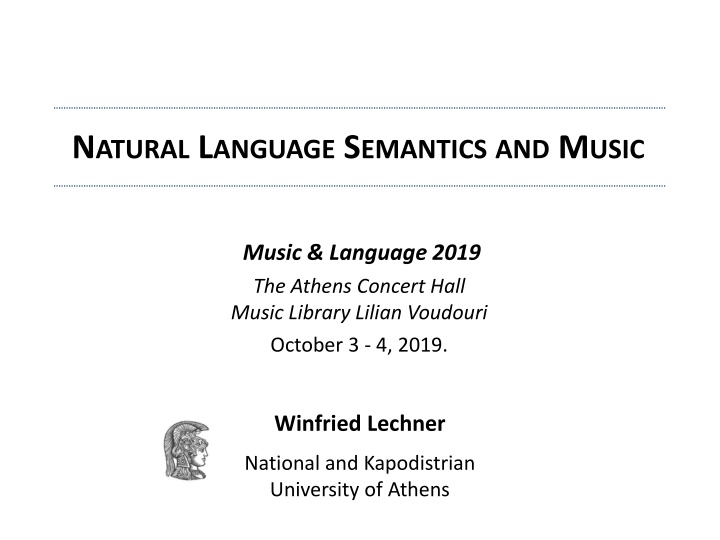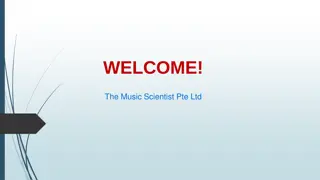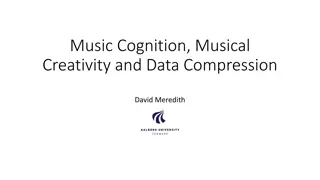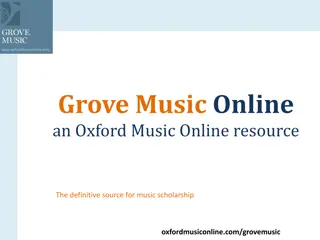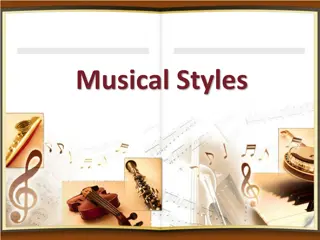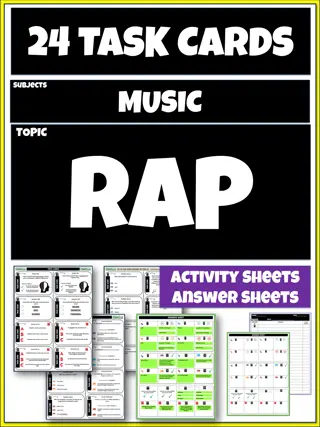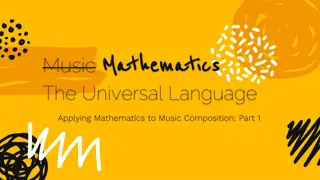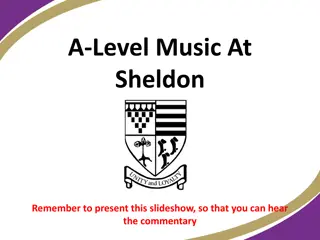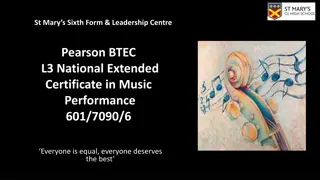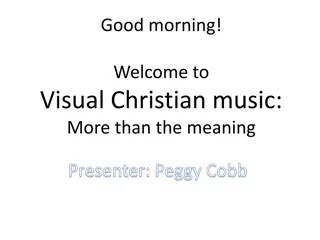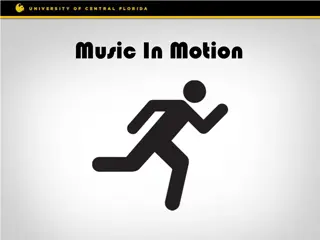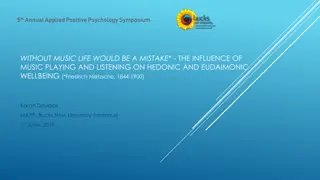Exploring the Relationship Between Language and Music
This presentation delves into the connection between language and music, examining the nuances of linguistic expressions, syntax, and meaning in both domains. It contrasts the formal structure of music with the combinatorial nature of natural language, discussing aspects such as denotation, reference, and the expressive power of music. The talk also touches on modality in both language and music, highlighting the internal systems that can be externalized through various physical means.
Download Presentation

Please find below an Image/Link to download the presentation.
The content on the website is provided AS IS for your information and personal use only. It may not be sold, licensed, or shared on other websites without obtaining consent from the author.If you encounter any issues during the download, it is possible that the publisher has removed the file from their server.
You are allowed to download the files provided on this website for personal or commercial use, subject to the condition that they are used lawfully. All files are the property of their respective owners.
The content on the website is provided AS IS for your information and personal use only. It may not be sold, licensed, or shared on other websites without obtaining consent from the author.
E N D
Presentation Transcript
NATURAL LANGUAGE SEMANTICS AND MUSIC Music & Language 2019 The Athens Concert Hall Music Library Lilian Voudouri October 3 - 4, 2019. Winfried Lechner National and Kapodistrian University of Athens
BEFORE WE BEGIN. WHAT THIS IS (NOT) ABOUT This presentation will be concerned with: o Meanings of linguistics expressions o Linguistic meanings undergirding concepts o Syntax, distributional invariants and meaning But this talk will not touch upon: o Meaning and truth/truth-conditions o Connotations, social meaning, expressive meaning, o Emotional expression of music (Rousseau, Herder, Helmholtz, .) o Koelsch s taxonomy of musical meaning (Koelsch 2012) 2
OVERVIEW Language vs. Music Form meaning mismatches Denotation and Reference Extensions and Intensions Concepts Consequences for music Inferences Quotations 3
LANGUAGE VS. MUSIC Language (natural) =def a discrete, combinatorial, compositional mental system for the conversion of meaning into sound Music Language (formal) =defthe set of all strings generated by a generative grammar Music Language (formal) =defa feature calculus/set of production rules generating strings without meaning Music. Opens up the possibility to study expressive power of music by inspecting propertries of strings. Where is it located on the Chomsky hierarchy? ( Rohrmeier) 4
LANGUAGE VS. MUSIC Language Music Discrete (atomic units) 1 Combinatorial Compositional (but see below) 2 Recursive Truth conditional Lexicon (atomic form meaning pairs) see below Categories see below Ambiguity ( Anagnostopoulou) Ellipsis (meaning without form) Expletives (form without meaning) Modality independent Duality of patterning 1Marin Mersenne (1588-1648): Harmonie Universelle. 2Lerdahl, Fred and Ray Jackendoff. 1983. A Generative Theory of Tonal Music. Cambridge MA: MIT Press. 5
MODALITY Modality. Language is a mind internal system that can be externalized by different physical means. Language converses Acoustic: spoken languages Visual: sign languages Tactile: Pro tactile sign languages non sensory: internal language/monologue Modality in music Acoustic Visual music, synaesthesia Tactile non sensory: internal language/monologue 6
DUALITY OF PATTERNING Emergence of meaning from meaningless primitives: Duality of patterning (Hockett, 1960) is the property of human language that enables combinatorial structure on two distinct levels: meaningless sounds can be combined into meaningful morphemes and words, which themselves could be combined further. de Boer, B., Sandler, W., & Kirby, S. (2012). New perspectives on duality of patterning: Introduction to the special issue. Language and Cognition, 4(4). Compare this to mathematics, where every symbol is assigned a designated meaning: o ciphers: 1, 2, .... 0 o operators: +, x o brackets: (.), <.>, 7
FORM-MEANING MISMATCHES Ambiguity. One form, more than one meaning ( Anagnostopoulou) (1) Show me the bat. (2) Mary spotted the thief with the binoculars. (3) John saw her duck. (4) Sally invited one linguist to every party. Ellipsis. Meaning without form. (5) John saw her duck, and Bill did, too. Expletives. Form without meaning (6) a. That John won is obvious. b. It is obvious that John won. 8
DENOTATION Denotation. For any expression , the denotation of (symbolic: ) is the semantic value of . Semantic competence.The ability of competent speakers of a language L to assign a denotation to every syntactically well- formed expression of L. (1) Heinrich Ignaz Franz Biber s son was the supervisor of Wolfgang Amad Mozart s father. Three foundational questions Q1. What is the denotation of the larges units (sentences)? Q2. What are the meanings of its smallest parts? Q3. How are the parts combined to form complex meanings? 9
REFERENCE Reference. The relation which obtains between a natural language expression and an individual in the world. o Some nominal expressions are referential: (1) Vladimir Putin (2) the president of the USA, this book over there o The referent can be abstract: (3) this sentence/thought you just produced (4) the 13thcentury o Other noun phrases lack reference: (5) Santa Clause, Hamlet, Batman, Vulcan (evaluated in our world ) (6) the largest prime number (7) no book, every book, most books (8) runVerb, tallAdjective, underPreposition, eachDeterminer 10
REFERENCE DENOTATION Sign. Arbitrary relation between form and meaning Ferdinand de Saussure (1857-1913) Charles Sanders Peirce (1839-1914) Arbitrary random! Arbitrary relations are systematic, but not grounded. Example for random mapping from form to meaning: For Mary, June 1, 9am, in Athens: For Mary, June 1, 10am, in Athens: For John, June 1, 9am, in Athens: tree = tree = tree = tree dog 3,1415.... 11
REFERENCE DENOTATION Common misconception. Words/signs relate mind internal representations (concepts) to reality. Language links the mind and objects in the world. Denotation = Reference Problem 1. Expressions without reference. (Batman, Vulcan, ) Problem 2. Even with arguable referential expressions (names), the relation between meaning and world is indirect. 12
DOUBLE VISION (1) Bill will win (the election). (2) Bill will not win. Contradiction (can t be both true) < (3) Mary thinks that Bill will win. (4) Mary thinks that Bill will not win. No contradiction (can be both true) Double vision scenario verifying (3) and (4). Mary is professionally acquainted with Bill, a promising candidate for the general elections, and is convinced that he will win. In the evening before the election, Mary joins a group of friends at a bar and they watch an interview with Bill on TV. Being drunk, Mary does not recognize Bill. Moreover, Mary does not like Bill s performance and believes that that guy on TV will loose. (Quine, Willard van Orman. Philosophy 53:177 187.) 1956. Quantifiers and propositional attitudes. Journal of 13
DOUBLE VISION AND RELATIVIZED CONCEPTS There is a concept of Bill for Mary, such that Mary thinks that Bill will win under that concept. There is a concept of Bill for Mary, such that Mary thinks that Bill will not win under that concept. Consequence. The name Bill is ambiguous and denotes one of two concepts, depending on Mary s acquaintance relation to Bill. (1) BillMary-live = the person Mary is acquainted with live, i.e. in reality = the person Mary saw on TV (2) BillMary-TV Analyzing Bill as ambiguous provides an analysis for double vision: (3) Mary thinks that BillMary-livewill win. (4) Mary thinks that BillMary-TVwill not win. true true 14
INTERIM SUMMARY (1) Mary thinks that BillMary-livewill win. (2) Mary thinks that BillMary-TVwill win. Formally, Bill denotes a function from possible individuals ( Mary live , Mary watching TV ) to possible individuals ( Bill live , Bill on TV ). Taking stock Concepts are (rather complex) functions. Semantic competence consists in the ability to acquire, compute and combine such functions. Meaning is notreference to objects in the world (or a fictional world). Consequence for musical semantics When searching for meaning in other systems (music), one should not look for possibly abstract individuals as values for the semantic domain, but for functions 15
THEORY OF MIND (1) (1) Mary thinks that Billwill win. The speaker s representation of Mary s belief that Bill will win. Theory of mind (ToM).The ability to reconstruct somebody else s mental representations. ToM is instrumental for social interaction, i.a. planning, collaborative action, lies,... ToM and language. On some accounts, ToM is dependent upon the acquisition of the semantics of think/believe-predicates. Musical ToM?The ability to reconstruct somebody else s musical representations (harmony, rhythm, melody,... ). Some observations ToM is not necessarily language dependent Concepts can be complex and reconstructed/inferred. Complex concepts are compositional. 16
EXTENSION AND INTENSION Each sign has two dimensions of meaning (Rudolf Carnap) Extension: meaning at a particular context (time/place) Intension: time/space independent meaning ( concept). INTENSION/CONCEPT EXTENSION May 31, 2008: Barack Obama PRESIDENT OF THE USA May 31, 2019: Donald Trump July 21, 1969: Neil Armstrong, Buzz Aldrin MAN ON THE MOON Oct. 03, 2019: { } Oct. 03, 2019, 3pm, Athens: {WL, } AWAKEAdjective Oct. 03, 2019, 3pm, Vienna: {PL, } universally: {2, 3, 5, 7, 11, 13, 17, } PRIME NUMBER Extension Intension + Context (i.e. time/place of evaluation) 17
CONCEPTS AS DEFINITIONS Concepts as definitions. Manifestations of a concept meet all the necessary and sufficient conditions for that concept. Example: BACHELOR =DEFUNMARRIED + MAN Problem 1. How to define necessary and sufficient ? Example: TABLE=DEFfour legs and a plane surface (Fodor 1981) but and Problem 2. Even closely related concepts have different satisfaction conditions. (1) Necessary conditions for HEALTHY: healthy in every respect (2) Necessary conditions for SICK: not healthy in some respect 18
CONCEPTS AS PROTOYPES Concepts as prototypes. Manifestations of the same concept are more similar than manifestation of different concept. Problem 1. Compositionality: PET FISH is neither typical pet nor fish. Problem 2. How to quantify similarity ? Observation. In general, similarity is context dependent. (1) (Regarding weight,) an elephant is similar to a car. (2) (Regarding color,) an elephant is similar to a flea. Which two individuals of A, B and C fall under the concept BIRD? A: humming bird B: chicken C: drone flies humming sound < 100g 19
STATISTICAL CONCEPTS Concepts as averages. Manifestations of the same concept are bound together by being above statistical average. Problem. How to define average ? Scenario. 2.5 is the threshold for positive health test. Dan excels in two of categories, but fails in the third one. Sam consistently scores low, but above average in all three tests. 6 Question. Who is healthier, Dan or Sam? 5 Blood pressure Pulse Predicted: Dan 4 3 Average health Dan: (5+5+2)/3 = 4 Average health Sam: (3+3+3)/3 = 3 2 1 Blood sugar Experimentally confirmed intuitions: Sam 0 Dan Sam (From Sasson, Galit. 2013. A typology of multidimensional adjectives. Journal of Semantics 30: 335-380.) 20
CONCEPTS: INNATENESS & UNIVERSALITY Nativism vs. Empiricism. Are concepts innate or learned? Pro nativism Mental computations require representations (R. Gallistel) Compositionality of concepts suggests innateness. Some concepts cannot be learned (Fodor; see TABLE). Perception and reasoning presupposes Kantian categories. Non-human specific concepts (location, food quality, ). There is no good theory of concept acquisition. Contra nativism Human made concepts (PHONE, TONE ROW, ATOMIC WEIGHT) There are cultural dependent concepts (HELL, DEMOCRACY, ). Some concepts are processed more effectively than others. 21
CONSEQUENCES FOR MUSIC Rules in language Lexicon: list of atomic signs (form - meaning correspondences) Each form is assigned a category: N (noun), V (verb), A (adjective), Rules are category sensitive. (1) a. Sentence NP VP b. John slept = The individual John is a member of the sleepers. (2) a. *Sentence AP VP b. *Tired slept (not attested in any language) = The tired individual is a member of the sleepers. Endocentricity: Rules create trees in which each larger phrase contains a matching head (e.g. NP a N b). Observation 1. Rules categories ( No rules without categories. ) Observation 2. Endocentricity categories ( Endocentricity presupposes categories. ) 22
CONSEQUENCES FOR MUSIC No Musical Lexicon Hypothesis (Katz & Pesetsky 2009) There are no form-meaning pairs (signs) in music. Hence music has no lexicon. Corollary 1. Provided that categories are lexically determined (but see Baker 2005), and music lacks a lexicon there are no categories in music. Observation 1. Rules Observation 2. Endocentricity categories categories Corollary 2. Given that categories underlie the existence of headed structures, music lacks endocentric structure. Observation 3. Rules operate on categories & create endocentric trees. Consequence of the No Musical Lexicon Hypothesis Since music lacks categories and endocentic structure there are no rules in music. 23
CONSEQUENCES FOR MUSIC Possible objection. Categories do not emerge from the syntactic part of the signs (partitioning of the forms), but are semantically grounded. Alternative: semantic grounding of categories. Are there semantic invariants for syntactic categories (noun, verb, adjective, )? Nouns denote things/objects (prime number, Batman) Verbs denote actions (to know, to exist) Adjectives denote properties (also true of verbs and nouns). Y Conclusion. Linguistic categories are not semantically grounded, at least not in an obvious way. Consequence 1. There is no reason to deny music a lexicon. A musical lexicon is just not made up of Saussurian signs. Consequence 2. Music might be better understood in terms of theories which collapse syntactic and semantic rules (Categorial Grammar, Granroth-Wilding & Stedman 2017). 24
CATEGORIAL GRAMMAR Categorial Grammar (CG) (Richard Montague, Mark Steedman, Anna Szabolcsi, i.a.) Syntactic & semantic rules are part of the lexical entries Small number of combinators Lexical categories reflect distributional invariants (1) sleep , run , are of category NP S (a sign that combines with an NP and creates a sentence) (2) John , the dog , . are of category NP (a sign that serves as input to NP S to creates a sentence) Music and CG. Harmonic chord progression (cadences) can be modeled in categorial framwork (Granroth-Wilding & Steedman 2017). (3) IV V I (4) IV is of category V I (chord that combines with dominant and results in tonic) 25
MUSICAL LEXICON Absence of denotations for musical primitives does not entail absence of a lexicon for music. A musical lexicon collects distributional invariants (cf. distributional semantics). Conjecture about musical semantics o The meaning of a musical primitive is the set of its possible contexts. o Meanings of complex expressions are functions from contexts to the meaning of the primitives. Observation. This dynamic perspective looks a lot similar to Heim/Kamp style Dynamic Semantics, where meanings are modeled as the potential change they induce in a context. 26
INFERENCES Inferences describe logical relations between syntactic objects (proof theory, calculus) or semantic objects (model theory). 1. Logical entailment. A entails B if B cannot be false if A is true. (1) Sally read all books. Sally read all brown books. (2) John sings and dances. John sings. 2. Presuppositions. Information that can be infered and is taken for granted by the speaker. (3) Mary began playing flute in 2000. Mary has not played flute before 2000. (4) The turtle died. There was exactly one (contextually salient) turtle. 27
INFERENCES 3. Implicatures. Information that follows from an utterance without being logically entailed. (1) John has three children. John has not more than three children. (implicature) Cancellability o An inference is cancelled if negating it or taking it back does not result in inconsistency/infelicity/queasiness. o Implicatures can be cancelled, logical entailments and presuppositions can t. 28
DISTINGUISHING AMONG INFERENCES Logical entailments cannot be cancelled (1) (2) Sally read all books. Sally did not read all books. (Contradiction) Implicatures can be cancelled Context. Citizens with three children are eligible for tax reduction. (3) (4) John has three children. So he can apply for tax reduction. In fact, John does not have three children, he has four. (No contradiction) Presuppositions cannot be cancelled (5) Mary stopped smoking. ( (6) #But in fact, she has never smoked. Mary used to smoke.) (Infelicitous) 29
INFERENCES IN MUSIC MUSIC o Inferences about chord or rhythmic progression: entailments, implicatures or presuppositions? o Are musical inferences best captured in terms of a syntactic, formal calculus (proof theory) or in terms of their semantic properties (model theory)? o Preparations ( Rohrmeier) as implicated presuppositions? A first stab [Help!]: Read G prepares C as C triggers the (cancellable) implicature that G presupposes C? o Idea: Is it possible to cancel inferences? How? 30
QUOTATION Direct quotation (1) Aristotle refers to Aristotle. (2) Quine said Quotations are interesting . (1) The string Aristotle refers to Aristotle. Mixed quotation (3) Alice said that life "is difficult to understand. (3) Alice said that life is difficult to understand and she used the words "is difficult to understand. Quasi quotation (Quine s corner quotes). Read n+1 as concatenate the value of n with + and with the value of 1 (4) If n is a natural number, then n+1 is a natural number. (5) If 2 is a natural number, then 2+1 is a natural number. If 3 is a natural number, then 3+1 is a natural number. 31
QUOTATION AND MUSIC Music. Citation of motives and forms is ubiquitious. Question. Is there an analogue to mixed or quasi quotation? Possible example for a complex case of quotation: The march in the fourth and final movement of Shostakovich s Symphony No. 5, whose sincerity is still under debate. Did Stalin get what he wanted (a triumphant celebration of the Soviet)? Was Mravinskij right in his assessment that the officials were served well? What did Shostakovich really quote? Further, related areas of exploration: Can the study of irony, metaphor, fictional truth in language (Daniel Altshuler, Emar Meier) inform about similar notions in music? 32
SUMMARY Natural language meaning is not reference based. Semantic competence consists in the ability to acquire and compositionally combine intensions/concepts. Intensions (concepts) are probably the basis of the Theory of Mind. While there is no good theory of concepts, formal semantics provides a good operational characterization of concepts. [not discussed today] Linguistic study of concepts affords insights into vagueness, indeterminacy, gradability, and genericity. The absence of signs does not entail that music lacks a lexicon. Musical meaning can be modeled in terms of distributional invariances. If musical inferences and quotations fall into different classes, the use of linguistic instruments/insights might turn out to be useful. 33
POSTSCRIPT: A QUESTION OF PERSONAL CURIOSITY Why are there so many musicians interested in and knowledgeable about the formal (mathematical, logical, acoustic, neurological, ) properties of their subject matter, but so few poets, playwrites, authors or even linguists? 34
SELECTED REFERENCES Arbib, Michael (ed.) 2013. Language, Music and the Brain. Cambridge, MA: MIT Press; papers in Part 2: Action, Emotion, and the Semantics Granroth-Wilding, Mark and Mark Steedman. 2014. A robust parser- interpreter for jazz chord sequences. Journal of New Music Research 43.4: 355 374. Koelsch, Stefan. 2012. Brain and Music. Oxford: Wiley-Blackwell. chapter 10. Schlenker, Philippe. 2019. Prolegomena to Music Semantics. Review of Philosophy & Psychology 10: 35-111. 35
